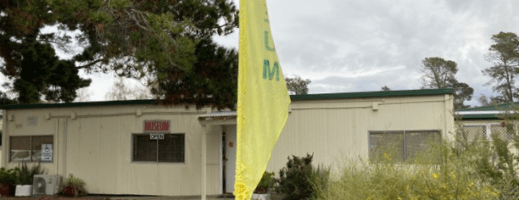By Rosemary Blemings.
 Raindrops that fall onto each of our Landcare volunteering sites may eventually reach the 40m high Ginninderra Falls and the Murrumbidgee River to the west of Parkwood, NSW. If you visit the high points of Gungahlin, Percival Hill, Mulligans Flat, and walk the Centennial Trail beyond Hall, the landscapes of Ginninderra Creek and its tributary creeks are laid out as a living map.
Raindrops that fall onto each of our Landcare volunteering sites may eventually reach the 40m high Ginninderra Falls and the Murrumbidgee River to the west of Parkwood, NSW. If you visit the high points of Gungahlin, Percival Hill, Mulligans Flat, and walk the Centennial Trail beyond Hall, the landscapes of Ginninderra Creek and its tributary creeks are laid out as a living map.
Hall Museum has a large collection of artefacts, photographs, maps and stories relating to the Indigenous millennia and 1880s settlement experiences in the catchment where we now live and enjoy Landcare. They all reveal the previous histories of the places we love, our neighbourhoods on the living map or those displayed at the museum.
One 1915 map details the incredible tree and “scrub” felling effort needed to create the settlers’ homestead sites, gardens, fences and paddocks for cropping and grazing. The museum’s collection includes hand tools, together with illustrated accounts of locals’ achievements as shops, schools, community halls, sports facilities, pubs and cemeteries morphed into the vibrant village that is decades older than Canberra.
Ginninderra Catchment hosted scores of homesteads and the mini-settlements necessary for agriculture to survive. All of the Landcare sites were once part of these historic places and some had schools for the settlers’ and labourers’ large families. Children had to walk miles across paddocks to Hall school, which opened in 1910. Did children walk across your site?
For at least 10,000 years before this, the Ngunawal people had special places across the landscape. They had refined ways of caring for Country in order to survive and thrive. Their pathways may have crossed through the habitats you care for. There were and are Songlines alongside the creeks. Some of their ancient stone artefacts and tools can be seen at the museum. Perhaps Lyall Gillespie recorded them from where your backyard is now?
Learn more about your Landcare site by visiting the diverse collections in the Old Schoolhouse and pine-tree fringed, former school buildings at Palmer Street, in Hall Village. Opened by volunteers each Thursday morning, 9am to 12 noon, and on Sundays, 12 noon to 4pm.
And www.museum.hall.act.au has a treasure trove of documented life in Ginninderra and Hall.

